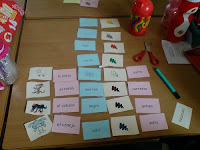Updated – all resources that still exist for this unit of work can be downloaded here. Hyperlinks within the post to resources in DocStoc no longer work.
As we near half term (and not a moment too soon!) the time has come to report back and evaluate how the four QCA Spanish units I’ve used have gone.
First up is Unit 5 Los Cuatro Amigos which I used with Year 3. It’s based around the story of four animal friends (hence the title) who find an apple tree and have to work together to reach and eat the lovely red apple that hangs on it. You can download the unit from the QCA site and below is the medium term planning that goes with the QCA document.
Scheme of work for Year3 spanish summer – los cuatro amigos
I had been sent a PPT presentation of the story by a kind person on the ELL-forum so we began by me reading the story from the IWB to the pupils and seeing how much they could understand-
- what’s it about?
- who are the characters?
- any words you think you might recognise? how?
- what do you think this might mean?
Then we picked out the words for the animals and added actions suggested by the pupils whilst looking at flashcards (on the IWB and laminated ones!) – again, thanks to another kind on a forum. I ‘d modified them slightly to be double sided with just the image on one side and the word (colour coded by gender) and image on the other side. The lesson continued with pupils showing their understanding through using the actions as we once more read the story. Already, the class were wanting to join in – especially with the ¡Pom, pom, pom! and ¡Yupí! sections!
To finish off, I’d prepared a simple worksheet with copying and drawing activities based on the new vocabulary.
The next lesson started with a recap of the story, using the actions once more to show understanding. As we reviewed the animal vocabulary, we discussed the grapheme / phoneme links for ll, j and z and tried to think of other Spanish words that included them – lots of colours and people’s names were suggested. Then, as suggested in the QCA document, we looked at the word galopa and picked out the other action words, using the pupils’ knowledge of sentence structure etc from their own language,their ability to pick out cognates and their understanding of how animals move! They were a bit puzzled by how sheep move but a bit of acting soon helped them catch on to running. We then used a flipchart to link words and pictures, guess the hidden animal / word etc.
Lesson 3 we revised colours – lots of pupils recalled these well, but many of the ones they remembered weren’t featured in the story eg azul, verde, amarillo. We looked for items of that colour in the room, played ‘Búscame algo …..‘ and then focussed on the story with questions about the colour of the apple and animals. WE did the suggested Hoop game making a Venn diagram with two hoops and putting words from the text into the hoops, their position dependent o n whether they contain ‘e’ or ‘i’ sound – if both, they went in the intersecting area.
n whether they contain ‘e’ or ‘i’ sound – if both, they went in the intersecting area.
eg oveja = e
ratoncito = i
conejito = e and i
The lesson carried on with a game of pelmanism – animal and word, and then coloured splodge and word. This is always a popular activity :o)
We used the same cards then to make phrases about the animals’ movement – eg el caballo + galopa.
Then once we had successfully done this, I asked the pupils to make phrases including colours. This was intially less successful as several pupils used English word order ie gris + el caballo + galopa (adjective noun verb) rather than el caballo + gris + galopa (noun adjective verb). However, once I drew them back to the text, they remembered last year when they all told me about word order being ‘odd’ in Spanish.
animalcolourverbwordcardsSpanish1
The next language focus was on how to make a sentence negative. Asking questions like ¿Un caballo galopa?, ¿Un ratón salta?, I modelled answers including sí and no and the more confident worked out how to reply in a phrase rather than by using gesture (thumbs up or down) or a single word. We wrote all the animal names and actions on mini whiteboards (allowing spelling practice too) then added some with sí and no, and made human sentences. I asked the question, we answered as a class and then the boards got in the right order. As confidence grew, we asked the question as a class and pupils with boards got up and ordered themselves depending on what the answer should be. And then we added additional vocabulary items, explained through mime such as baila – dances or canta – sings. This led to a riotous game of charades!
action verbs – Get more College Essays
The next week I departed from the QCA a little and planned to do a listen an order exercise with pupils listening to the story and putting cards into order according to what they heard. However, 3AB had other ideas and wanted to do it themselves. So I gave them the cards of cut up text and off they set, trying to put it into order. Some were more successful than others and but I was pleased to be able to discuss with pupils what they were doing, how they had a rrived at their answers and also how they might review the order by looking at certain words. After 10 minutes, I read the story and the groups checked their order, making adjustments as necessary.
rrived at their answers and also how they might review the order by looking at certain words. After 10 minutes, I read the story and the groups checked their order, making adjustments as necessary.
At this point, my plan had been to look further at the text and see if pupils could identify missing words from their memory. However, once more I adapted to the mood of the class who were really eager to tell the story and record it. Julia volunteered to start eh story, and never really stopped! You can listen to her beautiful storytelling with the class doing the choral parts with great gusto and me adding the odd bit on our podcast (you can see it in the player on the right of this post too). As it was unrehearsed, I was particularly pleased with Julia’s confidence and really quite accurate accent (cogió caused her consistent problem!)
Today was the last lesson on the topic and I lost all but 8 of the class to Area sports trials for half the lesson so we played some games with hoops. Some were not directly related to the topic -such as put your (body part) in the hoop which caused great hilarity; others were based on the vocabulary in the unit. We played a game with the animal flashcards in two different ways:
With the small group, we used the 4 hoops, each with an animal card in it. I called a phoneme eg ‘a’ and pupils had to stand in the hoop that contained a word with that phoneme eg la oveja / el caballo.
With the whole class, we stuck them on the walls and walked (very important as we were in the classroom!) to stand near to the appropriate word. Pupils soon worked out that there was more than one answer possible and we went on to suggest other words containing the same phoneme.
We finished off the topic with another retelling of the story – this time with no pictures – with each table representing one of the animals or the apple. When their animal / apple was mentioned in the text, they had to stand up, and everyone stood up for the apple tree. This was a good test of listening as the word for apple – la manzana and the word for the apple tree – el manzano are very similar.
I consider that the topic has been quite successful – the pupils have enjoyed it and can more accurately identify phoneme – grapheme links thus aiding their pronunciation – and are now self correcting and helping each other with new words. At the start of lesson3 or 4, I asked pupils how many words they could remember from the story and we made a list that filled the whiteboard of words, phrases and whole sentences – and they could spell most of them, and say what they meant. Phrases such as ‘Sí, ya voy‘ and ¿Quién es? are readily recalled now and can be used in classroom situations.
After half term, I teach the other year3 class and will repeat many of the same activities, but will probably add some different ones too, and perhaps explore some further ideas from the QCA document.
Updated – all resources that still exist for this unit of work can be downloaded here. Hyperlinks within the post to resources in DocStoc no longer work. All of the presentations were shared with me by others -thank you to the kind people who shared – and the story comes from the QCA unit not me! that do not originate from me – thank you to the kind people who shared.

















